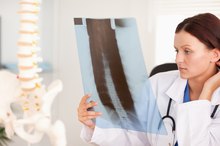What does fact checked mean?
At Healthfully, we strive to deliver objective content that is accurate and up-to-date. Our team periodically reviews articles in order to ensure content quality. The sources cited below consist of evidence from peer-reviewed journals, prominent medical organizations, academic associations, and government data.
The information contained on this site is for informational purposes only, and should not be used as a substitute for the advice of a professional health care provider. Please check with the appropriate physician regarding health questions and concerns. Although we strive to deliver accurate and up-to-date information, no guarantee to that effect is made.
Complications of Endovenous Laser Treatment
Endovenous laser treatment, or EVT, is a minimally invasive procedure used to treat varicose veins, according to VeinDirectory.org. This procedure is usually performed in a physician’s office or an outpatient clinic. During endovenous laser treatment, a laser fiber is inserted through the skin and directly into the affected vein. The intense heat from the laser causes the painful vein to collapse, shrink and eventually disappear. This procedure is usually performed on large varicose veins in the legs, and it usually takes approximately 30 minutes to complete.
If you are experiencing serious medical symptoms, seek emergency treatment immediately.
Phlebitis
A common complication associated with endovenous laser treatment is phlebitis, according to Charlottesville Vein Clinic in Charlottesville, Virginia. Phlebitis or thrombophlebitis occurs when a blood clot forms in one or more veins near the surface of the skin causing it to swell, according to the MayoClinic.com 1. People with this condition may experience warmth, redness, tenderness and pain in the affected area. Phlebitis usually arises in the veins in the legs, but it can also affect the veins in the arms and neck. People who have endovenous laser treatment may experience skin redness and tenderness near the affected veins after the procedure due to irritation, blood accumulation at the treatment site and immobility. Phlebitis usually improves within three to seven days without hospitalization. Treatment typically consists of self-care steps such as:
- elevating the leg
- applying heat to the painful area
- wearing support stockings
- using over-the-counter anti-inflammatory medications
- but in severe cases
- surgery may be needed remove a painful varicose vein
- open a blocked vein or prevent a loosened blood clot from reaching the lungs
- A common complication associated with endovenous laser treatment is phlebitis, according to Charlottesville Vein Clinic in Charlottesville, Virginia.
Deep Vein Thrombosis
Blood Clot After Surgery Symptoms
Learn More
People who have endovenous laser treatment may experience deep vein thrombosis after the procedure, according to the Medical Vein and Vasectomy Centre in New South Wales, Australia 2. In severe cases, the clot may loosen from the blood vessel and travel to the lungs or heart, causing a pulmonary embolism or heart attack. People who have endovenous laser treatment may develop blood clots or deep vein thrombosis after the procedure due to inactivity, vein inflammation and pooling blood or fluid near the treatment site 2.
Tender Lumps
People who have endovenous laser treatment may be at risk for developing painful lumps near the affected vein. The Medical Vein and Vasectomy Centre in Australia states that tender lumps may arise following the procedure as a result of trapped blood that has collected underneath the skin and around the treated vein. The discomfort may persist for the first weeks following the treatment and is usually a sign that the treatment was successful. If the lump continues to enlarge and the pain appears to worsen, surgery may be needed to reduce the pressure, break up the blood clots and stop the bleeding.
- People who have endovenous laser treatment may be at risk for developing painful lumps near the affected vein.
- The Medical Vein and Vasectomy Centre in Australia states that tender lumps may arise following the procedure as a result of trapped blood that has collected underneath the skin and around the treated vein.
Paresthesia
Vein Ablation Complications
Learn More
A common complication associated with endovenous laser treatment is paresthesia, or numbness and tingling in the skin, according to the United Kingdom’s Midlands Vein Clinic. People who have endovenous laser treatment may experience paresthesia following the procedure due to inactivity, nerve and vein irritation and inflammation near the treated vein. Normal sensation usually returns once the inflammation and pressure surrounding the treated vein decreases.
Related Articles
References
Writer Bio
R. Y. Langham served as a senior writer for "The Herald" magazine from 1996-99. Langham holds a Bachelor of Arts in English from Fisk University, a Master of Science in marriage and family therapy from Trevecca Nazarene University and a Ph.D in family psychology from Capella University. Dr. R.Y. Langham published her first psychological thriller in September 2011. It can be purchased on Amazon.com, Barnes&Noble.com and Lulu.com.









